The Evolution of Follicular Unit Extraction (FUE), Physicians, and its Tools
The following article is the result of an extensive review of modern Follicular Unit Extraction (FUE). The report, which analyzes the evolution of FUE hair transplant surgery, FUE surgeons, and differing FUE extraction tools, provides valuable information for interested patients and hair loss sufferers considering a follicular unit extraction procedure:
The Evolution of Follicular Unit Extraction (FUE), Physicians, and its Tools
Introduction
Of all the recent advances within the field of medical hair restoration, one that seems to garner the most attention from both hair loss patients and hair transplant surgeons is follicular unit extraction (FUE). Whether it’s the less invasive nature, lack of the linear scar associated with the traditional follicular unit transplantation (FUT) procedure, or potentially faster healing time, demand and popularity of FUE has increased greatly over the last several years. While most hair restoration experts believe that FUE has been traditionally overhyped or oversold to eager patients, it’s become evident that FUE is here to stay.
The lasting power of follicular unit extraction seems to stem from both patient demand and the dedication of talented hair restoration experts who continue perfecting the procedure, researching new extraction mechanisms, and creating new, more precise FUE tools. By evaluating these dedicated physicians, refined methods, and unique follicular unit extraction devices, this article briefly traces the evolution of FUE and attempts to shed some light on why the procedure continues increasing in popularity and demand each day.
Background
In 2002, veteran hair restoration surgeons Dr. William Rassman and Dr. Robert Bernstein published an article describing a new type of hair transplant surgery. In the editorial, Rassman and Bernstein outlined what they called the “FOX,” or follicular unit extraction (FOllicular unit eXtraction) procedure.
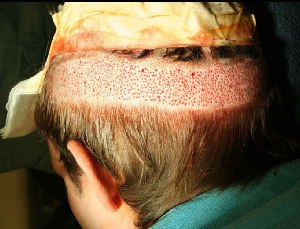 Unlike traditional follicular unit transplantation or strip surgery, where a strip of tissue containing hair follicles is removed, dissected, and implanted into the balding scalp, follicular unit extraction or FUE involves the direct removal of individual follicular units from the universal donor region, followed (usually) by immediate implantation. According to the FUE expert Dr. James Harris, this procedure, which eliminates the traditional follicular unit transplantation scar, follows an emerging trend of surgical procedures involving decreased trauma, less scarring, and a more rapid recovery.
Unlike traditional follicular unit transplantation or strip surgery, where a strip of tissue containing hair follicles is removed, dissected, and implanted into the balding scalp, follicular unit extraction or FUE involves the direct removal of individual follicular units from the universal donor region, followed (usually) by immediate implantation. According to the FUE expert Dr. James Harris, this procedure, which eliminates the traditional follicular unit transplantation scar, follows an emerging trend of surgical procedures involving decreased trauma, less scarring, and a more rapid recovery.
However, simply creating a less invasive mechanism of hair transplantation is not sufficient. In order for follicular unit extraction to survive and thrive, it must continue evolving and demonstrating excellent results. This excellence is obtained through the most important and variable aspect of the procedure: the operating hair transplant surgeon. However, the talent and innovation of these physicians extends beyond simply performing state-of-the-art FUE, as these same surgeons are also responsible for designing, creating, and improving follicular unit extraction tools. Since 2002, extraction tools have progressively evolved and allowed follicular unit extraction to secure a significant role in the field of medical hair restoration.
Follicular Unit Extraction or FUE Tools
Today, tools associated with the follicular unit extraction or FUE procedure are easily organized into two distinct categories: manual extraction tools and motorized (powered) extraction tools. These broad categories are further defined by differing models, continual updates, and the dedicated physicians who theorize and design the tools themselves.
Manual Follicular Unit Extraction Devices
Manual extraction devices are generally considered the “original” FUE tools, namely because these were the devices first used in follicular unit extraction procedures. The first tools, such as the extraction device used by Coalition members Dr. Rassman and Dr. Bernstein, were simple punch devices. The manual punch tool initially featured a small, sharpened, circular edge, and created a cylindrical incision around a follicular unit when pushed into the harvest zone.
During an FUE procedure with the sharpened punch tool, the surgeon isolates the desired follicular unit graft, places the punch above the
graft at an accurate angle, pushes the device to an appropriate depth (ensuring that the hair follicle is maintained), removes the punch, and extracts the graft gently with a pair of forceps. Each surgeon adds their own unique styling to the procedure (such as using a modified punch tool which features the ability to clamp, thus combining the incision and extraction process), but the procedure still revolves around the sharpened, manual punch.
Although the sharpened punch tool helped define the practice of follicular unit extraction, it suffered from several perplexing issues. The biggest issue stemmed from transection or an accidental slicing of the hair follicles and follicular unit grafts. In many cases, the direction or angle of the hairs below the scalp differs from the angle of the visible portion of the hair shaft above the scalp. When trying to follow this visible angle with the sharpened punch, surgeons run the risk of accidently transecting the hair follicle and implanting a damaged graft. This greatly decreased the growth rate and cosmetic appearance of the matured result.
To address this issue, Dr. James Harris developed the SAFE (Surgically Advanced Follicular Extraction) System, which utilizes a dull, unsharpened punch tool to avoid follicular transection. According to Dr. Harris, the SAFE method allows for a transection rate of less than 2%, which is equivalent to the transection rates seen in traditional follicular unit transplantation. Although the efficacy of manual extraction tools evolved to an impressive level, the time and energy associated with removing and implanting a large number of grafts via FUE still presented a difficult obstacle. In an attempt to retain this level of effectiveness while also increasing the speed of follicular unit graft removal, innovative hair restoration surgeons began investigating motorized FUE tools.
Motorized Follicular Unit Extraction Devices
Much like manual extraction devices, motorized FUE tools continue evolving, improving, and enhancing the practice of follicular unit extraction. According to Coalition member and FUE expert Dr. Alan Feller, effective motorized tools help standardize the practice of follicular unit extraction and are bringing the technique from a “cottage industry” art to a mainstream practice. However, as of this point in time, no singular motorized extraction tool is regarded as the field’s standard, and new, slightly different devices are released on a semi-frequent basis.
Although different devices utilize unique removal techniques, the most popular tools usually use some derivation of the rotating punch method. Like a manual punch device, the rotating punch isolates singular follicular units, makes a circular incision around the future graft, and punctures down to the level of the hair follicle. However, unlike manual punch devices, these tasks are normally completed in one motion by introducing motorized rotation. This motorized rotation is controlled by some type of switch, such as a foot pedal operated by the hair transplant surgeon during the operation.
According to Dr. Harris, motorized FUE tools offer the ability to remove 500 – 700 grafts per hour, whereas manual punch grafts allow surgeons to remove around 200 – 300 grafts per hour. In order to further describe motorized FUE, it’s easiest to analyze the devices used, and in many cases designed, by individual hair transplant surgeons.
Dr. Alan Feller – Advanced FUE Instruments
In early 2009, Dr. Alan Feller introduced his newest contribution to the field of follicular unit extraction – a motorized FUE device using his previously designed “Feller Punch”. Dr. Feller’s tool utilizes the rotating punch method, but is specially designed to avoid what he describes as four of the biggest problems associated with traditional motorized rotating punches: torsion, tension, friction, and heat. For more information, see, “What are the Benefits, Limitations, and Potential Problems with FUE?”
According to Dr. Feller, because other rotating heads oscillate at speeds up to 7,000 rotations per minute and utilize sharpened punches, excess stress (in the form of torsion, tension, friction, and heat) is placed on grafts and as a result, the final yield suffers.
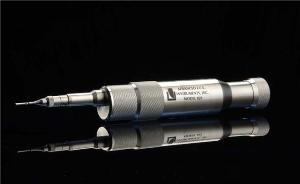 However, the Feller FUE device avoids these pitfalls by first, only allowing for a very small rotation (or oscillating) arc, which reduces torsion and heat strain by as much as 75%; second, using a special “perforation” technique, where the graft is merely loosened by the rotation and is then gently lifted and separated from the surrounding tissue by a needle, and third, by utilizing an unsharpened edge on the punch. Dr. Feller explains that this tool can extract around 350 grafts per hour with very minimal transection. It’s also worth nothing that Dr. Feller unveiled his new FUE device in a very unprecedented manner. Instead of keeping the device and mechanism a practice secret, he shared descriptions, videos, and explanations with the hair transplant community and offers the device to other medical practices. In fact, other reputable hair transplant surgeons such as Dr. Ron Shapiro and Dr. William Lindsey utilize or have used the Feller device in their own medical practices. See, “Introducing a new Revolutionary Follicular Unit Extraction (FUE) Tool” for more information on Dr. Feller’s motorized device.
However, the Feller FUE device avoids these pitfalls by first, only allowing for a very small rotation (or oscillating) arc, which reduces torsion and heat strain by as much as 75%; second, using a special “perforation” technique, where the graft is merely loosened by the rotation and is then gently lifted and separated from the surrounding tissue by a needle, and third, by utilizing an unsharpened edge on the punch. Dr. Feller explains that this tool can extract around 350 grafts per hour with very minimal transection. It’s also worth nothing that Dr. Feller unveiled his new FUE device in a very unprecedented manner. Instead of keeping the device and mechanism a practice secret, he shared descriptions, videos, and explanations with the hair transplant community and offers the device to other medical practices. In fact, other reputable hair transplant surgeons such as Dr. Ron Shapiro and Dr. William Lindsey utilize or have used the Feller device in their own medical practices. See, “Introducing a new Revolutionary Follicular Unit Extraction (FUE) Tool” for more information on Dr. Feller’s motorized device.
Dr. James Harris – The FUE Powered SAFE Scribe
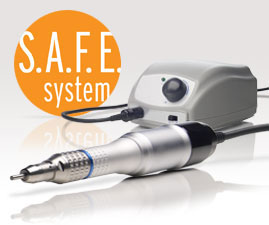 After revolutionizing the hair restoration industry with the introduction of the SAFE manual FUE technique, Dr. James Harris updated his follicular unit extraction practice by releasing his motorized device – the Powered SAFE Scribe. According to Dr. Harris, the Powered SAFE Scribe is minimally invasive, nearly pain free, creates no visible scarring, reduces post-operative healing time, and creates very minimal transection rates. Furthermore, Dr. Harris claims that nearly 100% of patients are candidates for FUE with the Powered SAFE Scribe, and it is a particularly useful FUE tool for individuals with gray hair and African American patients. The Powered SAFE Scribe also allows the surgeon to effectively remove up to 500 – 700 grafts per hour and, like the Feller tool, is available to other hair transplant surgeons. See, “Dr. Harris’ Motorized SAFE Scribe Tool Makes FUE Surgery Faster and Easier” for more information.
After revolutionizing the hair restoration industry with the introduction of the SAFE manual FUE technique, Dr. James Harris updated his follicular unit extraction practice by releasing his motorized device – the Powered SAFE Scribe. According to Dr. Harris, the Powered SAFE Scribe is minimally invasive, nearly pain free, creates no visible scarring, reduces post-operative healing time, and creates very minimal transection rates. Furthermore, Dr. Harris claims that nearly 100% of patients are candidates for FUE with the Powered SAFE Scribe, and it is a particularly useful FUE tool for individuals with gray hair and African American patients. The Powered SAFE Scribe also allows the surgeon to effectively remove up to 500 – 700 grafts per hour and, like the Feller tool, is available to other hair transplant surgeons. See, “Dr. Harris’ Motorized SAFE Scribe Tool Makes FUE Surgery Faster and Easier” for more information.
Dr. Jean Devroye – The Proprietary Motorized FUE Tool
In early 2009, Coalition member Dr. Jean Devroye began experimenting with his own motorized follicular unit extraction device. After months of careful research, Dr. Devroye perfected his device, which he named the Proprietary Motorized FUE Tool. Like the Feller tool, Devroye’s device is a rotary punch and reduces graft strain by taking advantage of a small, alternatively rotating (or oscillating) arc. Furthermore, the rotation is controlled by a foot pedal (or treadle), which allows the surgeon to focus both hands on the graft extraction. Additionally, Dr. Devroye utilizes a slightly larger punch on the edge of the tool (around 1 mm, compared to the 0.7 – 0.9 mm featured on other FUE devices), which he feels keeps transection minimal without creating unnecessary scarring. The Proprietary Motorized FUE Tool allows the surgeon to remove up to 1500 grafts in one sitting, and is available to other hair restoration physicians. See, “Dr. Devroye Continues to Improve Follicular Unit Extraction (FUE) Hair Transplant Surgery” for more information.
The NeoGraft Automated FUE Hair Transplant Machine
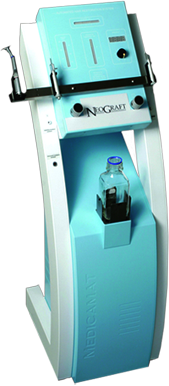 Although not created by a particular hair restoration surgeon, the NeoGraft FUE machine is relatively new and was very controversial and discussed by hair loss sufferers at its first release. Much like other motorized devices, the NeoGraft machine uses an adjustable, motorized rotating punch to remove follicular unit grafts from the universal donor region. However, unlike other devices the NeoGraft also features an attached vacuum tube, which sucks the removed grafts from the motorized head and ejects them into a collection canister post-extraction, and an optional pneumonic pressure suction feature, which allows the practitioner to suction the extracted grafts from the collection canister and implant them into the recipient area.
Although not created by a particular hair restoration surgeon, the NeoGraft FUE machine is relatively new and was very controversial and discussed by hair loss sufferers at its first release. Much like other motorized devices, the NeoGraft machine uses an adjustable, motorized rotating punch to remove follicular unit grafts from the universal donor region. However, unlike other devices the NeoGraft also features an attached vacuum tube, which sucks the removed grafts from the motorized head and ejects them into a collection canister post-extraction, and an optional pneumonic pressure suction feature, which allows the practitioner to suction the extracted grafts from the collection canister and implant them into the recipient area.
The controversy surrounding the NeoGraft machine is twofold: first, the machine markets itself as a device that allows even the most novice practitioner to perform FUE surgery safely and efficiently. However, since any surgical procedure requires a trained and experienced surgeon who’s able to adapt during the procedure, putting an advanced machine in inexperienced hands is potentially dangerous, shortsighted and detrimental to patient safety and the success of the procedure. Second, experts also point out that the additional handling and vacuuming involved in the NeoGraft extraction process creates unnecessary strain and stress on the fragile follicular unit grafts. For more information, view the article “Can the NeoGraft Hair Transplant Machine Revolutionize Follicular Unit Extraction?”
The ARTAS Hair Restoration System
Earlier this year, Restoration Robotics, a California based biotechnology and engineering company, introduced its newest innovation: the ARTAS Hair Restoration System. Like previous automated FUE extraction devices, such as the NeoGraft machine, the ARTAS Hair Restoration System attempts to both increase the speed of extraction (allowing for larger single sessions) and also automate the surgical process. By automating the process, the FUE procedure becomes standardized and minimizes the variability of practitioner’s skill and experience during the extraction process. However, most experts maintain that an experienced surgeon should be present during the procedure in order to adapt as necessary and that any machine in neophyte hands can be potentially dangerous to patients.
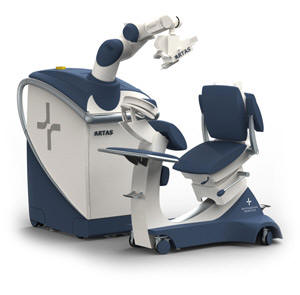 Recommended hair transplant surgeon and FUE expert Dr. James Harris became the first hair restoration physician to purchase the ARTAS. See “Dr. Jim Harris Purchases the First ARTAS Hair Restoration System for Automating the Follicular Unit Extraction (FUE) Procedure.” According to Dr. Harris, the ARTAS system offers patients another FUE option and should help increase consistency within the follicular unit extraction field. However, like most other experts, Dr. Harris does not believe this machine should be marketed to the neophyte FUE surgeon and confirms the idea that the surgeon, not the tool, determines the success of a hair transplant procedure. See “Dr. Harris Answers Critical Questions About the ARTAS Hair Restoration System” for further details.
Recommended hair transplant surgeon and FUE expert Dr. James Harris became the first hair restoration physician to purchase the ARTAS. See “Dr. Jim Harris Purchases the First ARTAS Hair Restoration System for Automating the Follicular Unit Extraction (FUE) Procedure.” According to Dr. Harris, the ARTAS system offers patients another FUE option and should help increase consistency within the follicular unit extraction field. However, like most other experts, Dr. Harris does not believe this machine should be marketed to the neophyte FUE surgeon and confirms the idea that the surgeon, not the tool, determines the success of a hair transplant procedure. See “Dr. Harris Answers Critical Questions About the ARTAS Hair Restoration System” for further details.
Conclusion
Through a combination of patient demand and physician dedication, follicular unit extraction is becoming more prominent in the hair transplant profession. As the experience and skill of physicians utilizing FUE continues evolving with the refinement of the tools used, patients are able to undergo larger sessions without sacrificing yield or introducing unnecessary scarring. Although there is currently no universal standard for FUE tools, nor will there most likely ever be, most new devices seem to improve upon the rotational punch model by increasing the speed at which grafts can be extracted and by reducing the follicular stress associated with more primitive forms of motorized FUE tools.
It is important to understand that most surgeons still highly recommend the follicular unit transplantation (FUT) technique, and view FUE as an exciting new procedure that currently serves as an effective alternative therapy for a certain patient base. Furthermore, these FUE tools are designed for use by trained hair transplant surgeons, and while they help experienced surgeons practice more effectively, they are not a “magic wand” that allows untrained practitioners to perform FUE.
References and Resources
Avram, M.R., and Rogers, N.E. 2010. Hair Transplantation. New York, NY: Cambridge University Press.
Physician contributions:
James Harris, M.D. is a recommended hair transplant surgeon practicing medical hair restoration in Greenwood Villiage, Colorado.
Alan Feller, D.O. is a member of the Coalition of Independent Hair Restoration Surgeons practicing medical hair restoration in Great Neck, New York
Jean Devroye, M.D. is a member of the Coalition of Independent Hair Restoration Surgeons practicing medical hair restoration in Bruxelles, Belguim.
William Rassman, M.D. is a member of the Coalition of Independent Hair Restoration Surgeons practicing medical hair restoration in Los Angeles, California.
Robert Bernstein, M.D. is a member of the Coalition of Independent Hair Restoration Surgeons practicing medical hair restoration in New York, New York.
_______________
Blake Bloxham – formerly “Future_HT_Doc”
Editorial Assistant and Forum Co-Moderator for the Hair Transplant Network, the Hair Loss Learning Center, the Hair Loss Q&A Blog, and the Hair Restoration Forum
Follow our community on Twitter
Watch hair transplant videos on YouTube
Get Proven Hair Loss Treatments at the Best Prices by visiting our new Online Hair Loss Product Store
Technorati Tags: Follicular Unit Extraction, FUE, FUE hair transplant surgery, FUE surgeon, FUE extraction tools, hair loss sufferers, follicular unit extraction, medical hair restoration, hair transplant surgeons, follicular unit transplantation, FUT, hair restoration surgeons, follicular unit transplantation, strip surgery, follicular units, follicular unit transplantation scar, FUE tools, FUE procedure, motorized FUE tools, Feller FUE device, Powered SAFE Scribe, NeoGraft FUE machine, NeoGraft machine, ARTAS Hair Restoration System, automated FUE extraction devices, FUE expert



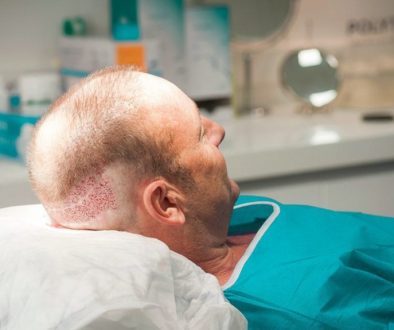
February 8, 2016 @ 6:21 am
Hi, any info on PCID Fue device? Is it any good?
September 16, 2013 @ 10:07 am
You can read more about the Choi technique and other FUE implantation techniques and devices by visiting “FUE Hair Transplant: Implantation Devices and Methods“.
I hope this helps.
Bill – Managing Publisher of this Community
September 15, 2013 @ 5:32 pm
what about Choi technique. Dr Hakan Donogay, seems to get excellent results? Any info?
March 23, 2013 @ 10:12 pm
The comments above are well stated. NeoGraft the machine is a true marvel. Utilizing sharp punches, the suction extraction provides minimal depth extractions, and not only decreases follicular transection, but such minimal depth causes transections that do occur to be inconsequential in that they are not likely to cause termination of the hair follicle.
This said, the NeoGraft machine is a surgical instrument, and should be used by surgeons only. Many medical decisions are made during the process of extraction, and this should not be delegated to unlicensed technicians. Hair transplanation in general has a long history of delegation of the surgical procedure, so it should come at no surprise that this has occurred. But it should no longer be allowed, and prospective patients should know before agreeing to a procedure what role the physician is playing during the procedure.
August 15, 2012 @ 12:03 pm
Dar,
NeoGraft is just a tool, not a procedure. Thus, to say you had “NeoGraft” 22 months ago is not an accurate statement. What you had 22 months ago is an FUE procedure by a surgeon who happened to be using the NeoGraft Machine.
You sound a lot more like someone promoting the NeoGraft than a genuine patient who’s interested in sharing his experience and opinion. Thus, if you work for NeoGraft, I suggest being honest about it for the sake of open and transparent discussion.
The NeoGraft Machine, in an expert physicians hands may indeed be an excellent tool. But it is not a replacement for a qualified physician. Unfortunately, NeoGraft started a campaign some time ago suggesting that neophyte surgeons or non-surgeons(those with little or no experience) could use their device and generate results on par with with leading physicians. This generated a significant amount of concern since a tool is only as good as the one who uses it.
If you are indeed a satisfied patient, congratulations. I encourage you to share your experience, your physician’s name and your photos on our popular hair loss discussion forum.
Best wishes,
Bill
August 11, 2012 @ 5:15 pm
I had NeoGraft 22 months ago and had 600 grafts done. What a difference it made. I am preparing for 1500 to 2000 more by the end of the year. All my grafts survived and your post of concerns just doesn’t jive – at least for me. A plastic surgeon and his staff worked on me. It was a great procedure. FUE is the future. I think NeoGraft has made it possible for more physicians to offer this procedure and in the end, the patients WIN…Competition is good.
Your article seems so against NeoGraft – while every other device mentioned is more positive. Why? Do you know that a simple search on google for NeoGraft shows really well tranied plastics and dermatologist and cosmetic surgeons who provide. These doctors are the best of the best….not the case with other device owners and the general population of the more established hair restoration providers…most D.O., family, etc. I love the USA because we can all have an opinion…and my opinion of yours is not good.